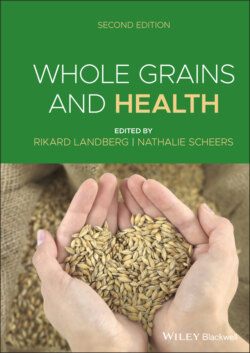Читать книгу Whole Grains and Health - Группа авторов - Страница 70
4.7 Digestibility of dietary fibre
ОглавлениеDietary fibres such as arabinoxylan, pectin, cellulose, β‐glucan and resistant starch are often mentioned regarding the health benefit of whole grain foods (Lattimer and Haub 2010; Cho et al. 2013). Related to starch digestion and glucose absorption, viscous‐forming fibres (e.g., β‐glucans, water‐soluble arabinoxylans) in some whole grain foods have been shown to moderate diffusion kinetics of α‐amylase and its digested products to the small intestine epithelial cells for glucose production by the mucosal α‐glucosidases (Blackburn and Johnson 1981; Johnson and Gee 1981; 2013). High viscosity of β‐glucans lowered in vitro starch digestion (Kim and White 2013), and the zero‐shear viscosity of jejunal digest containing β‐glucans was found to negatively correlate with glucose absorption in a pig study (Ellis et al. 1995). Other whole grain sources do not have appreciable amounts of viscous‐forming fibres, though cellulose as an insoluble fibre has been shown to inhibit α‐amylase activity to reduce starch digestion (Dhital et al. 2015).
Short chain fatty acids generated through fibre fermentation by the colon microbiota induce the release of the gut hormone peptide YY (PYY) (Wen et al. 1998) and GLP‐1 (Tollhurst et al. 2012) to slow gastric emptying, promote insulin secretion and moderate glycemic response. This creates a “second‐meal effect” first described by Jenkins et al. (1982; Brighenti et al. 2006). Thus, dietary fibres can slow the absorption of glucose or other nutrients from both its physiochemical property such as high viscosity (Zijlstra et al. 2012) and the ileo‐colonic brake systems, which enhance carbohydrate quality of whole grain foods.
